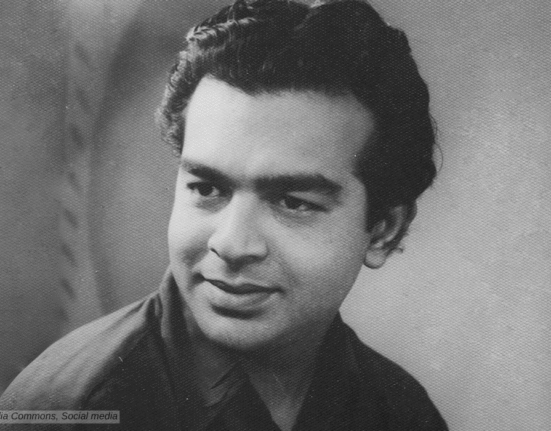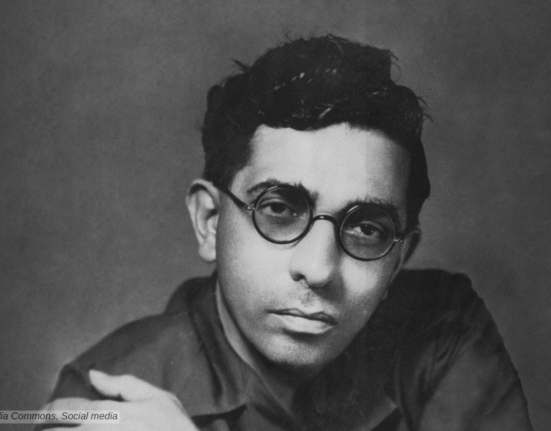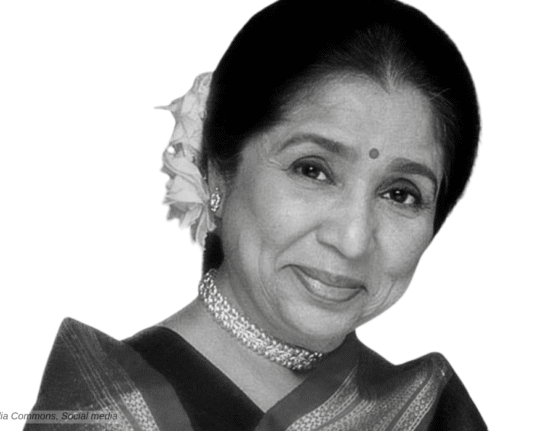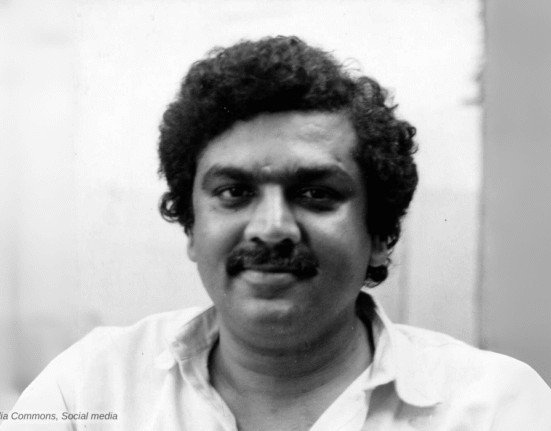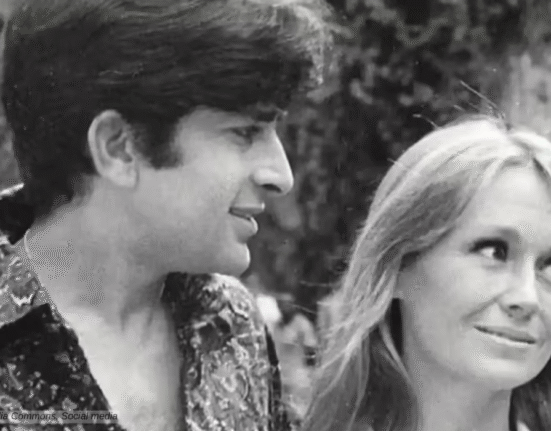When people talk about male singers of the golden era, they talk about the trinity of Rafi, Mukesh, and Kishore, but they don’t realize that three more singers were equally capable, famous, and loved, and those were the man with the velvet voice, Hemant Da; the Ghazal King, Talat Mahmood; and the versatile Manna Dey.
Manna Dey, fondly called Manna Da, was the classical backbone of the playback singing of that era. Loved and revered by all his contemporaries, he was often lauded for his versatility and his penchant to experiment. He sang it all, from classical like “Phul Gendedwa na maro,” Qawwali like “Na to Karwan ki Talash hai,” Bhajan such as “Yashomati maiya se,” fast numbers like “Twist Karen,” slow renditions like “Aye Mere Pyare watan,” Lori like “Tujhe suraj kahun ya chanda,” and love songs like “Dil ki Girah Khol do.” Manna Da was your one-stop solution for all genres and styles.
“It was never like that in our time. Outside the studio we were the best of friends and shared our joys and sorrows with each other.”
Manna Dey on his friendship with fellow artists and ugly rivalry of today
Birth of a Legend
Manna Dey was born as Prabodh Chandra Dey on May 1, 1919, in Calcutta. His uncle, Krishna Chandra Dey, was a legendary musician, singer, actor, and music teacher who significantly influenced the young Prabodh. KC Dey recognized and nurtured Manna’s talent from a young age. Manna Dey also learned music from Ustad Dabir Khan. Dey’s formal education began at Indu Babur Pathshala, followed by the Scottish Church Collegiate School and the Scottish Church College. It was the time when he honed his skills, not only in music but also in sports, excelling in wrestling and boxing.
Manna Dey’s career took a professional turn when he started working as an assistant music director under his uncle in films such as Chanakya (1939). Later, he assited legendary S.D. Burman in the early 1940s. Along with his work as an assistant, he continued training in classical music with Ustad Aman Ali Khan and Ustad Abdul Rahman Khan.
Manna Dey – The Singer

His debut as a playback singer came with the film ‘Tamanna’ in 1943, under the music direction of KC Dey, where he sang the duet “Jago Aayee Usha Ponchi Boley Jago” with Suraiya. His first solo song, “Gayi tu gayi Seeta sati,” comes in Vijay Bhatt’s Ram Rajya (1943), under the music direction of Shankar Rao Vyas.
Manna went on to sing many songs like “O Prem Diwani Sambhal Ke Chalna (Kadambari),” “Dil Churaney Ki Liye (Dur Chaley),” “E Diniya Jara Suney (Kamala),’ “Aaj Bor Aayee (Chaltey Chaltey), “Hay Gagan Me Badal Tharey (Vikaramaditya),” “Aowji Morey” (Insaaf),” “Kit Ho Nando Kumar,” “Chorr Sakhi Aaj Laj,” “Apney Hi Rang,” and “Lalit Labang Lata” in Geet Govind.
Breakthrough
However, it was the 1950s that marked the beginning of his golden era. His song “Upar Gagan Vishal” in the movie ‘Mashaal’ became a nationwide sensation, establishing him as a prominent voice in the industry. In his early career, he regularly worked with composers like Anil Biswas, Shankar Rao Vyas, S.K. Pal, S.D. Burman, Khemchand Prakash, Mohd. Shah, and Vasant Desai.
In the early 1950s, he sang for films like Ham bhi Insaan Hai (1948), Rambaan (1948), Awaara (1951), Andolan (1951), Rajput (1951), Jeevan Nauka (1952), Qurbani (1952), Parineeta (1953), Chitrangada (1953), Do Bigha Zamin (1953), Mahatma (1953), and many more.


The Voice with a difference
Dey’s classical training was not just limited to vocal practices. It encompassed a comprehensive understanding of the theoretical aspects of music as well. This rigorous training regime enabled him to master complex compositions and execute them with technical proficiency and emotional depth. His ability to blend the nuances of classical music with the film singing set him apart from his contemporaries.
Throughout his illustrious career, Manna Dey’s classical foundation was evident in the way he approached his songs. Whether it was the intricate alaaps, the precise taans, or the expressive bhavas, his classical influence was unmistakable. It was this classical prowess that composers sought when they needed someone to perform their most challenging compositions.
The Golden Period
In 1954, Manna Dey sang “lapak jhapak too aare badarwa” in Raj Kapoor’s “Boot Polish” under Shankar Jaikishan. It was the beginning of an almost two-decade-long relationship between them. They produced many hit songs for films such as Shree 420, Chori Chori, Mera Naam Joker, Awaara, and Kal Aaj Aur Kal.
Some of his famous songs are “Tu Pyar Ka Sagar Hai” from Seema (1955), “Yeh Kahani Hai Diye Aur Toofan Ki” from Diya Aur Toofan (1956), “Humdum Se Gaye” from Manzil (1960), “Aye Mere Pyare Watan” from Kabuliwala (1961), “Laga Chunari Mein Daag” from Dil Hi Toh Hai (1963), “Sur Na Saje” from Basant Bahar (1956), “Kaun Aya Mere Mann” from Dekh Kabira Roya (1957), “Pucho Na Kaise Maine Rain” from Meri Surat Teri Aankhen (1963), “Jhanak Jhanak Tore Baje Payalia” from Mere Huzoor (1965), “Kisne Chilman Se Mara” from Baat Ek Raat Ki (1962), “Ae Meri Zohra Jabeen” from Waqt (1965), “Chalat Musafir Moh Liya” from Teesri Kasam (1967), “Aao Aao Sawariya” & “Ek Chatur Naar” from Padosan (1968), and many more.
Collaborations of Manna Dey
He worked with almost all the music directors of that era, including Naushad, K. Dutta, Vasant Pawar & Ram, Ravi, Avinash Vyas, S. N. Tripathi, Sanmukh Babu, Nissar Bazmi, Husanlal Bhagatram, N. Bali, Sushanta Banerjee, O. P. Nayyar, Ghulam Mohhammed, Roshan, and Sapan Jagmohan.
Manna Da’s duets like “Pritam Daras Dikhao” Chacha Zindabad (1959), “Masti Bhara Yeh Sama” Parvarish (1958), “Nain Mile Chain Kahan” Basant Bahar (1956), “Kehdoji Kehdo Chupaona Pyar” Kismat Ka Khel (1956), “Tum Gagan Ke Chandrama” Sati Savitri (1964), “Dil Ki Girah” Raat Aur Din (1966), and “Chunari Sambhal Gori” Baharon Ke Sapne (1967) are also well loved by audiences.
Continuing Legacy
Manna Dey was known for his ability to sing across various genres, from classical to even modern pop. His unique blend of classical and contemporary styles made his voice universally appealing and timeless. Be it “Ae Bhai Zara Dekh Ke” or “Ae Mere Pyare Watan,” he never missed a beat nor an emotion. His “Kasame Vaade Pyar” from Upkar and “Yari Hai Iman Mera” in Zanjeer are other examples of his versatility.
In the 1970s, Manna De sang for films like Neel Kamal (1968), Ek Phool Do Mali (1969), Pushpanjali (1970), Mera Naam Joker (1970), Anand (1971), Lal Patthar (1971), Buddha Mil Gaya (1971), Anubhav (1972), Bawarchi (1972), Seeta Aur Geeta (1972), Shor (1972), Avishkaar (1973), Zanjeer (1973), Bobby (1973), Resham ki Dori (1974), Sholay (1975), Ponga Pandit (1975), Deewaar (1975), Mehbooba (1976), and Satyam Shivam Sundaram (1978).
“Tujhme Ishwar, Allah Tujhme” (Nanha Farishta, 1969), “Tujhe Suraj Kahun Ya Chanda” (Ek Phool Do Mali, 1969), “Nadiya Chale Re” (Safar, 1970), “Zindagi Kaisi Hai Paheli” (Anand, 1971), “Tum Bin Jeewan Kaisa Jeewan” and “Bhor Aaye Gaya Andhera” (Bawarchi, 1972), “Hasne Ki Chah Ne Kitna Mujhe” (Avishkaar, 1973), “Gori Tori Paijaniya” (Mehbooba, 1976), “Yeh Dosti” (Sholay, 1975), and “Band Mutthee” (Chalti Ka Naam Zindagi, 1981) are some of his iconic songs from his later career.
Decline of Hindi Film Music
Manna Dey cut off his workload in the early 1980s by singing in selected movies. He almost withdrew himself from Hindi film music in the 1990s. He continued to sing in occasional Bengali movies or do live performances until 2012. Some of the films in which he sang during that period are Abdullah (1980), Kranti (1980),
Karz (1980), Laawaris (1981), Prahaar (1990), and Umar (2006).
Over his illustrious career spanning more than five decades, Manna Dey recorded over 3,000 songs in multiple languages. His contributions were recognized with many prestigious awards. He got the Padma Shri in 1971, the Padma Bhushan in 2005, and the Dadasaheb Phalke Award in 2007.
Later Years
In December 1953, Manna Dey married Sulochana Kumaran. Together they have two daughters: Shuroma Herekar (1956–2016), who was a scientist, and Shumita Dev (b. 1958), who is a businesswoman.
Manna Dey’s passing on October 24, 2013, left a void in the world of music. Yet, his melodies continue to resonate, capturing the hearts of generations. His life and work remain a source of inspiration for future generations of musicians.
Manna Dey on IMDB




